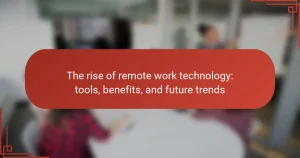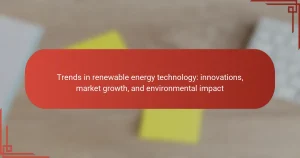5G technology significantly enhances urban infrastructure by facilitating faster communication and improved connectivity, essential for smart city applications like traffic management and energy efficiency. With data transfer speeds reaching up to 10 Gbps, 5G allows for real-time data processing, supporting a larger number of devices within the Internet of Things (IoT) ecosystem. However, the deployment of 5G faces challenges such as high infrastructure costs, regulatory hurdles, and public opposition. Effective integration strategies, including small cell deployment, network slicing, and beamforming, are crucial for overcoming these obstacles and ensuring robust connectivity in urban environments.
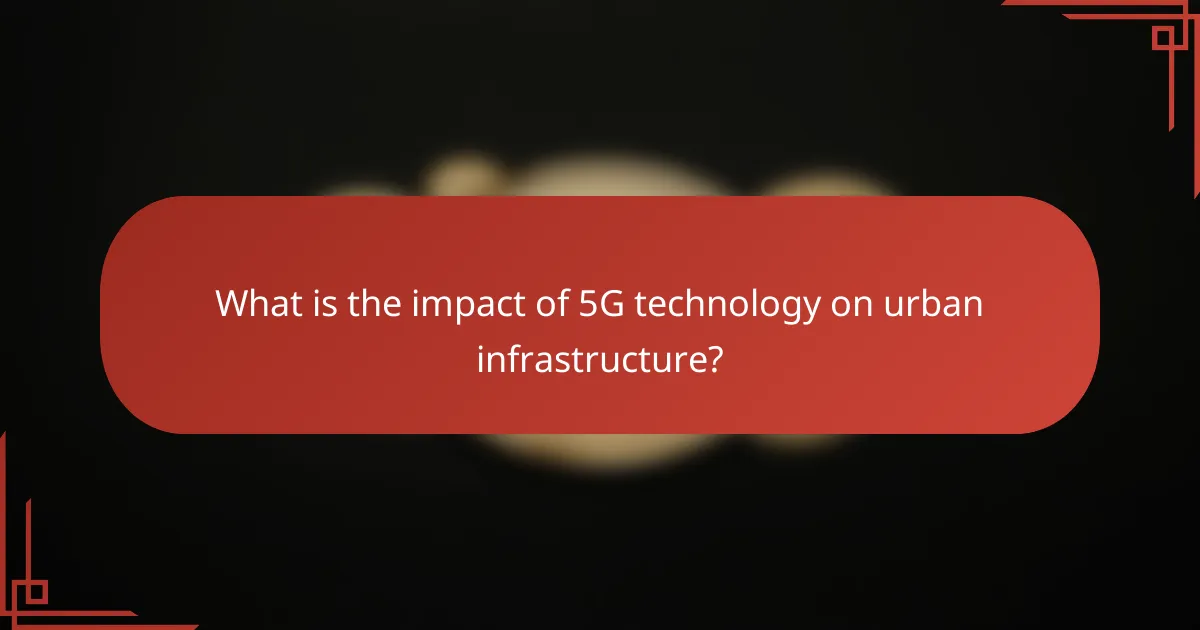
What is the impact of 5G technology on urban infrastructure?
5G technology significantly enhances urban infrastructure by enabling faster communication and improved connectivity. It supports smart city applications, such as traffic management and energy efficiency. With 5G, data transfer speeds can reach up to 10 Gbps, which is substantially faster than 4G. This speed facilitates real-time data processing and analytics. Additionally, 5G can connect a larger number of devices simultaneously, supporting the Internet of Things (IoT) ecosystem. Urban infrastructure can benefit from reduced latency, which improves response times for critical services. Enhanced connectivity can lead to better public safety measures and more efficient public transportation systems. According to a study by the GSMA, 5G could contribute $2.2 trillion to the global economy by 2030, underscoring its potential impact on urban development.
How does 5G technology differ from previous generations?
5G technology differs from previous generations primarily in its speed, capacity, and latency. It offers download speeds up to 10 Gbps, significantly faster than 4G’s peak of 1 Gbps. 5G supports a larger number of devices per square kilometer, enabling connections for up to one million devices. Latency in 5G can be as low as one millisecond, compared to 4G’s 30-50 milliseconds. This reduced latency enhances real-time communication and applications like autonomous vehicles. Additionally, 5G utilizes a broader spectrum, including millimeter waves, which allows for higher data rates and improved performance in dense urban environments. These advancements enable new applications such as smart cities and IoT integration.
What are the key features of 5G technology?
5G technology features ultra-fast data speeds, reaching up to 10 Gbps. It supports low latency, with response times as low as 1 millisecond. 5G enables massive device connectivity, accommodating up to 1 million devices per square kilometer. It operates on a broader spectrum, including millimeter waves, enhancing bandwidth availability. 5G technology enhances network reliability and efficiency through advanced MIMO (Multiple Input Multiple Output) technology. It supports network slicing, allowing tailored services for different applications. These features collectively improve urban infrastructure, facilitating smart city developments and IoT integration.
How does increased speed and bandwidth affect urban services?
Increased speed and bandwidth enhance urban services by enabling faster data transmission and improved connectivity. This leads to more efficient public transportation systems, as real-time data can optimize routes and schedules. Emergency services benefit from quicker communication, allowing for faster response times. Smart city applications, such as traffic management and energy distribution, become more effective with higher bandwidth. Studies show that cities with upgraded infrastructure experience a 30% reduction in traffic congestion. Enhanced connectivity also supports remote work and education, increasing accessibility for residents. Overall, improved speed and bandwidth are crucial for modernizing urban services and enhancing quality of life.
What are the benefits of implementing 5G technology in urban areas?
Implementing 5G technology in urban areas enhances connectivity and speeds up data transmission. It supports the growth of smart cities by enabling real-time data exchange. This technology can significantly reduce latency to as low as 1 millisecond. Higher bandwidth allows more devices to connect simultaneously without degradation of service. Enhanced mobile broadband improves user experiences for applications like streaming and gaming. 5G also fosters innovation in sectors such as healthcare, transportation, and public safety. For instance, remote surgeries and autonomous vehicles benefit from its capabilities. Studies indicate that cities adopting 5G can see economic growth due to increased efficiency and productivity.
How can 5G enhance public safety and emergency services?
5G can enhance public safety and emergency services by providing faster data transmission and improved connectivity. This technology enables real-time communication between first responders and command centers. Emergency services can access critical information instantly, improving response times. 5G supports high-definition video streaming for remote monitoring of incidents. It allows for better coordination among various agencies during emergencies. The technology also facilitates the use of IoT devices, enhancing situational awareness. For instance, connected sensors can provide live updates on environmental conditions. Studies indicate that 5G can reduce latency to as low as 1 millisecond, which is crucial during emergencies.
What economic advantages does 5G bring to urban infrastructure?
5G technology brings significant economic advantages to urban infrastructure by enhancing connectivity and efficiency. It enables faster data transmission and improved communication among devices. This leads to optimized resource management in utilities and transportation. For instance, smart grids can reduce energy costs by 10-30% through better demand response. Additionally, 5G supports the development of smart cities, which can attract investments. Research indicates that cities adopting 5G may experience a 1.5% increase in GDP over a decade. Furthermore, 5G facilitates innovations in sectors like healthcare and logistics, driving job creation and economic growth.
In what ways does 5G improve connectivity for smart city initiatives?
5G improves connectivity for smart city initiatives by providing higher data transfer speeds and lower latency. This technology enables real-time communication between devices, enhancing the efficiency of urban services. With speeds up to 10 Gbps, 5G supports a massive number of connected devices simultaneously. This capability facilitates the integration of IoT devices in smart infrastructure. Additionally, 5G’s low latency, around 1 millisecond, allows for immediate responses in critical applications like traffic management. Enhanced connectivity supports advanced applications such as smart lighting and waste management systems. Furthermore, 5G networks can cover larger areas with fewer base stations, reducing infrastructure costs. This increased coverage ensures that rural and underserved urban areas benefit from smart city initiatives as well.
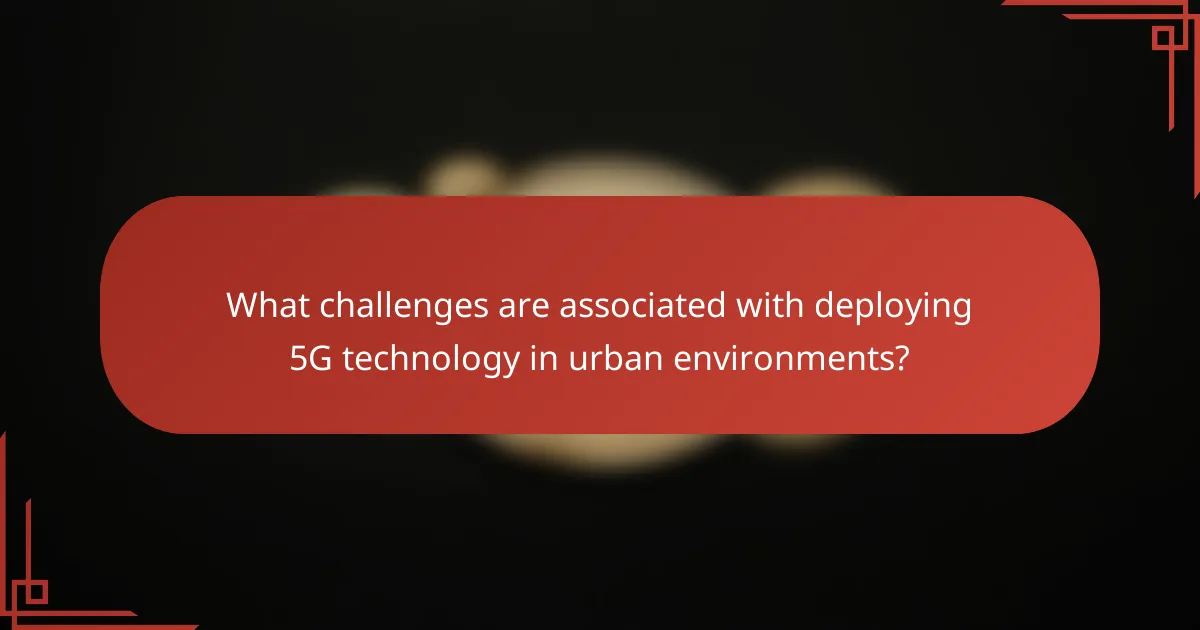
What challenges are associated with deploying 5G technology in urban environments?
Deploying 5G technology in urban environments faces several challenges. High infrastructure costs are a significant barrier. Urban areas require dense networks of small cell towers for optimal coverage. This necessitates substantial financial investment from service providers. Regulatory hurdles complicate deployment. Local governments may have varying regulations regarding tower placement and permits. Additionally, existing infrastructure may not support 5G technology. Upgrading older systems can be expensive and time-consuming. Public opposition can also hinder deployment efforts. Residents may resist the installation of new towers due to aesthetic concerns or health fears. Lastly, interference from buildings and other structures poses technical challenges. Urban environments often have dense construction that obstructs signal propagation. These factors collectively impede the swift rollout of 5G technology in cities.
What are the technical challenges of 5G deployment?
The technical challenges of 5G deployment include the need for extensive infrastructure upgrades. 5G requires a denser network of small cells compared to previous generations. This necessitates significant investment in new hardware and installation. Additionally, the high-frequency signals used in 5G have limited range and [censured] capabilities. This leads to challenges in coverage, especially in urban areas with many obstacles. Interference from buildings and other structures can degrade signal quality. Moreover, there are challenges related to spectrum allocation and regulatory compliance. The transition from 4G to 5G also involves ensuring compatibility with existing technologies. These factors collectively complicate the deployment process and timeline.
How do infrastructure limitations impact 5G rollout?
Infrastructure limitations significantly hinder the rollout of 5G technology. Insufficient fiber optic networks restrict the necessary backhaul capacity for 5G. Limited access to existing cellular towers complicates the installation of new 5G equipment. Urban areas with outdated infrastructure face challenges in meeting the high-speed demands of 5G. Regulatory hurdles can delay the deployment of new infrastructure. The cost of upgrading existing systems can be prohibitive for many providers. Areas lacking adequate power supply may struggle to support the energy needs of 5G equipment. Overall, these limitations can slow down the transition to widespread 5G availability.
What are the concerns regarding data privacy and security with 5G?
Concerns regarding data privacy and security with 5G include increased vulnerability to cyberattacks. The higher data speeds and connectivity of 5G create more entry points for hackers. Additionally, the use of network slicing can lead to unintended data exposure across different segments. Privacy issues arise from the vast amount of personal data collected by connected devices. The potential for surveillance increases as 5G enables more extensive tracking capabilities. Regulatory frameworks may lag behind technological advancements, leaving gaps in security measures. Research indicates that 5G networks may not be inherently secure without robust encryption and authentication protocols. These factors collectively heighten the risks associated with data privacy and security in 5G environments.
What regulatory and policy challenges must be addressed?
Regulatory and policy challenges for 5G technology deployment include spectrum allocation, infrastructure sharing, and public safety regulations. Spectrum allocation must ensure sufficient bandwidth for 5G services while avoiding interference with existing technologies. Infrastructure sharing policies can facilitate faster deployment by allowing multiple providers to use common assets. Public safety regulations must address concerns about potential health effects from increased electromagnetic exposure. Local zoning laws can also pose challenges by restricting where 5G infrastructure can be installed. Additionally, privacy and data security regulations need to be updated to protect user information in a more connected environment. These challenges require collaboration between government agencies, industry stakeholders, and communities to develop effective solutions.
How do zoning laws affect the installation of 5G infrastructure?
Zoning laws significantly affect the installation of 5G infrastructure by regulating where antennas and equipment can be placed. These laws determine the types of structures that can host 5G technology, such as rooftops or utility poles. Local governments enforce zoning regulations that may require permits for installations. This can lead to delays in deployment due to lengthy approval processes. Additionally, zoning restrictions can limit the number of sites available for 5G infrastructure. For example, areas designated for residential use may have stricter rules compared to commercial zones. These limitations can hinder the overall coverage and speed of 5G networks. Consequently, effective communication between telecom companies and local authorities is crucial for successful deployment.
What role do government regulations play in 5G deployment?
Government regulations play a crucial role in 5G deployment. They establish the framework for spectrum allocation, which is essential for 5G networks. Regulations ensure that frequencies are available and assigned to telecom operators efficiently. Compliance with safety standards is mandated by government bodies to protect public health. Local regulations can also influence the placement of infrastructure, such as cell towers. Streamlined permitting processes can expedite deployment timelines. Additionally, regulations can promote competition among providers, enhancing service quality. Countries with supportive regulatory environments tend to see faster 5G rollout. For instance, the Federal Communications Commission in the U.S. has implemented policies that facilitate quicker access to infrastructure.
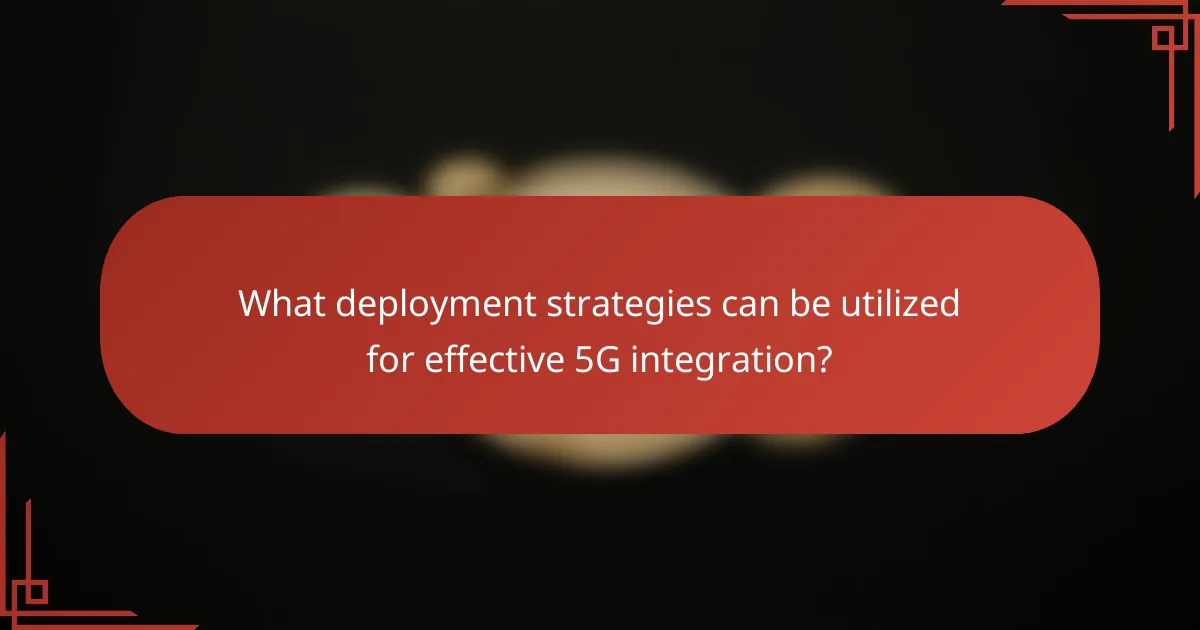
What deployment strategies can be utilized for effective 5G integration?
The primary deployment strategies for effective 5G integration include small cell deployment, network slicing, and beamforming. Small cell deployment involves installing numerous low-power nodes to enhance coverage and capacity in urban areas. This strategy is crucial due to the higher frequency bands used in 5G, which have limited range. Network slicing allows for creating virtual networks tailored to specific applications or services, optimizing resource allocation. Beamforming technology directs signals to specific users, improving efficiency and reducing interference. These strategies collectively address the challenges posed by urban infrastructure, ensuring robust 5G connectivity.
What are the best practices for planning 5G infrastructure?
The best practices for planning 5G infrastructure include comprehensive site surveys, strategic location of small cells, and collaboration with local authorities. Site surveys help identify optimal locations for antennas and equipment. Small cells enhance coverage and capacity in densely populated areas. Collaboration with local authorities ensures compliance with regulations and community needs. Additionally, integrating fiber backhaul is crucial for network performance. Planning for future scalability is essential to accommodate growing data demands. Implementing robust security measures protects the network from vulnerabilities. Regular assessments and updates to the infrastructure adapt to technological advancements.
How can cities prioritize areas for 5G deployment?
Cities can prioritize areas for 5G deployment by analyzing population density and demand for high-speed connectivity. High-density urban areas typically require more robust infrastructure to support user needs. Additionally, cities should assess economic activity and identify key business districts that would benefit from enhanced connectivity.
Public safety and emergency services areas also warrant priority, as reliable communication is crucial in these zones. Infrastructure readiness is another factor; locations with existing fiber optics can facilitate faster deployment.
Moreover, cities can engage with community stakeholders to understand specific needs and preferences. Data from mobile network operators can provide insights into current usage patterns. According to a report by the Federal Communications Commission, areas with higher data consumption should be prioritized for 5G rollout.
By combining these factors, cities can create a strategic plan that maximizes the benefits of 5G technology.
What partnerships are essential for successful 5G implementation?
Successful 5G implementation requires partnerships among telecommunications companies, government agencies, and technology providers. Telecommunications companies provide the infrastructure and network capabilities essential for 5G. Government agencies facilitate regulatory frameworks and spectrum allocation necessary for deployment. Technology providers contribute innovative solutions and equipment to enhance network performance. Collaboration among these entities accelerates the rollout of 5G networks. For instance, the partnership between Verizon and the city of Los Angeles enabled faster deployment of 5G services. Additionally, partnerships with local businesses help tailor 5G applications to meet community needs. These collaborations ensure that 5G technology effectively supports urban infrastructure development.
How can urban planners ensure equitable access to 5G technology?
Urban planners can ensure equitable access to 5G technology by implementing inclusive infrastructure policies. They should prioritize areas with limited connectivity. This involves identifying underserved neighborhoods and allocating resources accordingly. Collaborative partnerships with telecom companies can enhance service deployment. Public engagement is essential to understand community needs. Planners should promote affordable pricing models for low-income residents. Additionally, integrating 5G into public transportation and community centers increases access. Data from the Federal Communications Commission (FCC) indicates that 25% of rural Americans lack access to broadband. Addressing this gap is crucial for equitable technology distribution.
What strategies can be employed to address the digital divide?
Strategies to address the digital divide include increasing access to affordable internet services. Public-private partnerships can enhance infrastructure development in underserved areas. Government initiatives can provide subsidies for low-income households to access broadband. Educational programs can improve digital literacy among marginalized communities. Community centers can offer free internet access and training sessions. Mobile hotspots can be deployed in remote areas to expand connectivity. Finally, promoting competition among internet service providers can lower costs and improve service quality.
How can community engagement enhance 5G deployment efforts?
Community engagement can significantly enhance 5G deployment efforts by fostering local support and collaboration. Engaged communities are more likely to understand the benefits of 5G technology. This understanding can lead to reduced opposition and increased willingness to accommodate infrastructure changes. Local input can help identify optimal locations for 5G towers and other equipment. Engaging with residents can address concerns about aesthetics, health, and privacy. Studies show that when communities are involved, projects often proceed more smoothly and efficiently. For example, cities that have actively involved residents in planning have reported faster deployment timelines. Overall, community engagement creates a cooperative environment that is essential for successful 5G implementation.
What are some practical tips for cities adopting 5G technology?
Cities adopting 5G technology should prioritize infrastructure planning. This includes assessing current assets and identifying necessary upgrades. Collaboration with telecom providers is essential for effective deployment. Cities must also engage with local stakeholders to address community needs. Implementing small cell technology can enhance coverage and capacity. Additionally, establishing clear regulations for installation can streamline processes. Investing in cybersecurity measures is crucial to protect networks. Finally, conducting public awareness campaigns can help residents understand 5G benefits. These strategies ensure a smoother transition to advanced connectivity.
The main entity of this article is 5G technology and its impact on urban infrastructure. The article provides a comprehensive overview of how 5G enhances urban services through faster communication, improved connectivity, and support for smart city applications. It discusses the differences between 5G and previous generations, highlighting key features such as ultra-fast data speeds and low latency. Additionally, the article addresses the economic advantages, challenges of deployment, regulatory hurdles, and strategies for effective integration of 5G in urban environments, emphasizing the importance of community engagement and equitable access.

